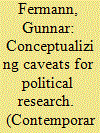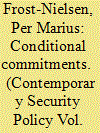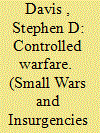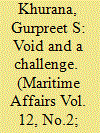| Srl | Item |
| 1 |
ID:
166604


|
|
|
|
|
| Summary/Abstract |
The upsurge in post-Cold War coalition operations has stimulated research on caveats: national reservations on the use of force in multinational military operations. However, because the concept of caveats has no agreed-upon definition, it is used inconsistently. This in turn impedes comparing research findings across academic and policy studies and therefore systematic research. This article is a contribution to the scholarly debate on how the analytical concept of caveats are to be delimited. Crucially, we argue that caveats result from some calculated political decision, and should not be confused with reserved behavior due to financial and technical limitations, or lack of coordination. We suggest that caveats are empirically observed and measured in two ways: First, we argue that coalition rules of engagement should be used as a yardstick for measuring direct reservations on the use of force. Second, we suggest reservations on task-assignment and geographical mobility should be used to register indirect reservations.
|
|
|
|
|
|
|
|
|
|
|
|
|
|
|
|
| 2 |
ID:
156086


|
|
|
|
|
| Summary/Abstract |
Why do states make substantial military contributions to coalition operations, while at the same time apply reservations, or caveats, to how the coalition can use the military contributions? Caveats rose to prominence in defense and policy circles with NATO’s campaign in Afghanistan. In the scholarly security literature, the term remains a buzzword for all types of reserved efforts by states in coalition warfare, but there are few theoretical accounts addressing caveats. This article contributes to the knowledge gap on caveats through a comparative case study of Denmark’s, the Netherlands’, and Norway’s contributions to NATO’s intervention in Libya in 2011. It demonstrates that caveats can occur through three different causal pathways: compromises from domestic bargaining, handling of alliance commitments, and implementation and civil–military relations. Insights into the complexity that causes caveats are highly relevant for both political and military decision-makers that are trying to coordinate states’ effort in coalition operations.
|
|
|
|
|
|
|
|
|
|
|
|
|
|
|
|
| 3 |
ID:
139096


|
|
|
|
|
| Summary/Abstract |
US military operations are increasingly conducted within urban environments and with these operations come the risk of increasing the number of civilian casualties and infrastructure damage. The use of non-lethal weaponry, such as directed-energy weapons, is one method for minimizing collateral damage. This method enables US military forces to effectively fight within urban environments through force escalation capabilities. Using a series of historical examples and future scenarios for urban warfare, this article highlights deficiencies affecting military capabilities in military urban operations, addresses the consequences of collateral damage, assesses the effectiveness of directed-energy weapons in military urban operations and encourages further funding, research and integration of non-lethal weaponry, such as directed-energy weapons, within the US military.
|
|
|
|
|
|
|
|
|
|
|
|
|
|
|
|
| 4 |
ID:
141833


|
|
|
| 5 |
ID:
150587


|
|
|
|
|
| Summary/Abstract |
The armed forces are usually conversant with the rules on the use of force against the enemy in the traditional battle space. However, military forces are usually ill-equipped for this when the opponent is not a regular combatant but an un-uniformed person – a militant or even a criminal – operating in seemingly benign environs. This constitutes a serious legal void, particularly given the emerging environment wherein navies would be increasingly tasked to perform non-traditional constabulary functions. The trend is best exemplified by the case of the Indian Navy that was entrusted with the responsibility for the nation's overall maritime security, including coastal and offshore security. This paper examines the concept and the salient issues relating to rules of engagement (RoE) for maritime forces operating in the low-intensity conflict environment.
|
|
|
|
|
|
|
|
|
|
|
|
|
|
|
|